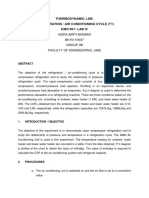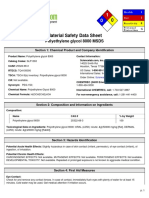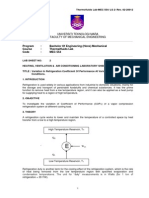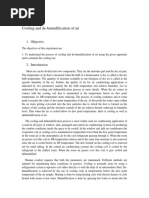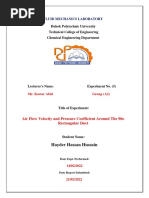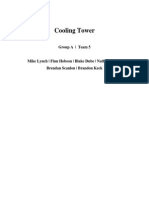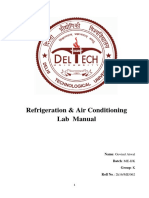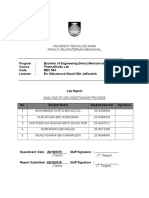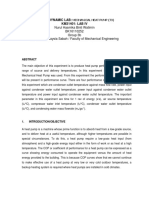Refrigeration Lab Complete
Refrigeration Lab Complete
Uploaded by
SyahirzabidiCopyright:
Available Formats
Refrigeration Lab Complete
Refrigeration Lab Complete
Uploaded by
SyahirzabidiOriginal Description:
Copyright
Available Formats
Share this document
Did you find this document useful?
Is this content inappropriate?
Copyright:
Available Formats
Refrigeration Lab Complete
Refrigeration Lab Complete
Uploaded by
SyahirzabidiCopyright:
Available Formats
Thermofluids Lab-MEC 554/ LS 2/ Rev.
02-20012
TITLE : Variation In Refrigeration Coefficient Of Performance At Various
Operating Condition
1.0 INTRODUCTION
Heat flows in the direction of decreasing the temperature which is from high
temperature regions to low temperature regions. This heat transfer process occurs in nature
without requiring any devices. But the reverse process cannot occur by itself. The transfer
of heat from a low temperature region to a high temperature one requires special devices
called refrigerators. Refrigerators are cyclic devices and the working fluid used in the
refrigeration is called refrigerants.
Another device that transfers heat from a low temperature medium to a high
temperature one is the heat pump. Refrigerators and heat pumps are essentially the same
device but differ in terms of objectives. The objective of the refrigerator is to maintain the
refrigerated space at a low temperature by removing heat from it. Discharging this heat to
higher temperature medium is merely necessary part of the operation, not the purpose. The
objective of a heat pump is to maintain a heated space at a high temperature. This is
accomplished by absorbing heat from a low temperature source, such as well water or cold
outside air in winter, and supplying this heat to a warmer medium such as a house.
Refrigeration is used widely in various applications from industrial to domestic
situations, mainly for the storage and transport of perishable foodstuffs and chemical
substances. It has the prime function to remove heat from a low temperature region, and it
can also be applied as a heat pump for supplying heat to a region of high temperature.
2.0 OBJECTIVE
To investigate the variation of Coefficient of Performance (COPR) of a vapor compression
refrigeration system at different cooling load.
Thermofluids Lab-MEC 554/ LS 2/ Rev. 02-20012
3.0 THEORY
The Carnot cycle is a totally reversible cycle that consists of two reversible
isothermal and two isentropic processes. It has the maximum thermal efficiency for given
temperature limits and it serves as a standard against which actual power cycles can be
compared. The reversed Carnot cycle is the most efficient refrigeration cycle operating
between two specified temperature levels. But however, this cycle cannot be approximated
in the actual devices and is not a realistic model for refrigeration cycles due to difficulty in
maintaining isothermal condition during the heat absorption and heat rejection processes.
A refrigeration cycle works to lower and maintain the temperature of a controlled space by
heat transfer from a low to a high temperature region.
High Temperature Reservoir, TH
QH
Wnet
QL
Low Temperature Reservoir, TL
Refrigeration duty is another term for the cooling effect of the refrigeration system,
which is the rate of heat being removed from the low temperature region with specified
evaporation and condensation temperatures. The unit for duty measurements is in Watts
(for 1 ton of refrigeration = 3517W).
Thermofluids Lab-MEC 554/ LS 2/ Rev. 02-20012
3.1
The Vapor Compression Cycle
An ideal refrigeration system follows the theoretical Reversed Carnot Cycle
process. In practical refrigerators, compression and expansion of a gas and vapor mixture
presents practical problems in the compressor and expander. Therefore, in practical
refrigeration, compression usually takes place in the superheated condition and a throttling
process is substituted for the isentropic expansion.
Thermofluids Lab-MEC 554/ LS 2/ Rev. 02-20012
In an ideal vapor-compression refrigeration cycle, The refrigerant enters the
condenser as superheated vapor at state 1 and leaves as saturated liquid at state 2 as a result
of heat rejection to the surroundings. The temperature of the refrigerant at this state is still
above the temperature of the surroundings. The saturated liquid refrigerant at state 2 is
throttled to the evaporator pressure by passing it through an expansion valve or capillary
tube. The temperature of the refrigerant drops below the temperature of the refrigerated
space during this process.
The refrigerant enters the evaporator at state 3 as a low quality saturated mixture,
and it completely evaporates by absorbing heat from the refrigerated space. The refrigerant
leaves the evaporator as saturated vapor. Then the refrigerant enters the compressor at state
4 as saturated vapor and is compressed isentropically back to the condenser pressure. The
temperature of the refrigerant increases during this isentropic compression process to well
above the temperature of the surrounding medium.
The cycle :
1 2 Condensation of the high pressure vapour during which heat is transferred to the
high temperature region.
2 3 Adiabatic throttling of the condensed vapour from the condensing to the
evaporating pressure.
3 4 Evaporation of the low pressure liquid during which heat is absorbed from the low
temperature source.
4 1 Isentropic compression of the vapour, from the evaporating to the condensing
pressures.
Thermofluids Lab-MEC 554/ LS 2/ Rev. 02-20012
Energy Transfers Analysis
Compressor
q4-1 = h4 h1 + w4-1
If compression is adiabatic, q4-1 = 0, and w4-1 = h1 h4 = wcomp
Power requirement, P = (h1 h4), where is the flow rate of working fluid per unit
time.
Condenser
q1-2 = h2 h1 + w
w = 0, therefore q1-2 = h2 h1 and rate of heat rejection Q1-2 = ( h2 h1 )
Expansion Valve
q2-3 = h3 h2 + w
w = 0, therefore q 2-3 = h2 h3 and process is assumed adiabatic q 0
therefore h2 = h3
Evaporator
q34 = h4 h3 + w
w = 0 therefore q34 = h4 h3 and rate of heat absorbed Q34 = ( h4 h3 )
Coefficient of Perfomance, COPref:
COPref =
h h3
q3 4
= 4
h1 h4
w
Thermofluids Lab-MEC 554/ LS 2/ Rev. 02-20012
4.0 EQUIPMENT
TH Series Computer Linked Refrigeration Unit (Edibon).
Thermofluids Lab-MEC 554/ LS 2/ Rev. 02-20012
5.0 PROCEDURES
6a) Condenser-water and evaporator-water
a. Water is selected as a heat source by opening valves AVS-4 and AVS-5.Then
START is clicked
b. The water flow rate is adjusted at the condenser to 5 L/m and 3 L/m at the
evaporator (evaporator load).
c. Then COMPRESSOR is clicked
d. When the system is stabilized, the data is recorded by click START SAVING
e. The sampling rate is set at 120 second per sample.
f. The data for six minutes is recorded (3 samples @ 360 second). STOP
SAVING
g. Then evaporator load is increased to 5 L/m and step (c) to step (f) is repeated.
6b) Condenser-water and evaporator-air
a. Air is selected as a heat source by opening valves AVS-3 and AVS-5.Then
START is clicked.
b. The water flow rate is adjusted at the condenser to 5 L/m and the air flow of the
evaporator is adjusted until 50% of the maximal flow (evaporator load).
c. Then COMPRESSOR is clicked.
d. When the system is stabilized, the data is recorded by click START SAVING
e. The sampling rate is set at 120 second per sample.
f. The data for six minutes is recorded (3 samples @ 360 second). STOP
SAVING
g. Then evaporator load is increased to 100% and step (c) to step (f) is repeated.
6c) Condenser-air and evaporator-air
a. Air is selected as a heat source by opening valves AVS-3 and AVS-6. Then
START is clicked
b. The air flow of the condenser is adjusted to maximum flow (100%) and 50% of
the maximal flow at the evaporator (evaporator load).
c. Then COMPRESSOR is clicked.
d. When the system is stabilized, the data is recorded by click START SAVING
e. The sampling rate is set at 120 second per sample.
f. The data is recorded for six minutes (3 samples @ 360 second). STOP
SAVING
g. Then the evaporator load is increased to 100% and step (c) to step (f) is
recorded.
6d) Condenser-air and evaporator-water
a. Water is selected as a heat source by opening valves AVS-4 and AVS-6.Then
START is clicked.
b. The air flow of the condenser is adjusted to maximum flow (100%) and the
water flow rate is adjusted at the evaporator to 3 L/m (evaporator load).
c. Then COMPRESSOR is clicked.
d. When the system is stabilized, the data is reorded by click START SAVING
e. The sampling rate is set at 120 second per sample.
f. The data is recorded for six minutes (3 samples @ 360 second). STOP
SAVING
g. Then the evaporator load is increased to 5 L/m and step (c) to step (f) is
repeated.
7
Thermofluids Lab-MEC 554/ LS 2/ Rev. 02-20012
6.0 DATA AND RESULTS
Thermofluids Lab-MEC 554/ LS 2/ Rev. 02-20012
table
Thermofluids Lab-MEC 554/ LS 2/ Rev. 02-20012
Result summary table
Time (s)
Exp #
Vref
(m3/s)
v2 (table)
(m3/kg)
mref (kg/s)
= Vref/v2
h3 (kJ/kg)
h4 (kJ/kg)
Qevap (kW)
= mref (h4 h3)
COP =
Qevap/ (SW1/1000)
120
0.003
1.006*10-3
2.982
54.688
2451.0
7145.802
14.55
240
0.003
1.008*10-3
2.976
54.688
29.303
2470.1
7263.812
15.03
360
0.003
1.008*10-3
2.976
29.303
2470.1
7263.812
15.29
14.96
Average COP
a
120
0.005
1.008*10-3
4.960
`29.303
2470.1
12106.353
25.27
240
0.005
1.008*10-3
4.960
29.303
2470.1
12106.353
25.43
360
0.005
1.008*10-3
4.960
29.303
2470.1
12106.353
25.48
Average COP
25.39
120
0.0015
0.0199
0.075
225.94
2345.5
158.967
0.33
240
0.0015
0.0199
0.075
225.94
2357.5
159.867
0.33
360
0.0015
0.0199
0.075
225.94
2357.5
159.867
0.33
0.33
Average COP
b
120
0.003
0.0199
0.151
251.42
2354.5
317.565
0.66
240
0.003
0.0173
0.173
251.42
2345.5
363.832
0.75
360
0.003
0.0173
0.173
251.42
2345.5
363.832
0.75
Average COP
0.72
120
0.0015
0.0199
0.075
251.42
2345.5
157.056
0.35
240
0.0015
0.0199
0.075
251.42
2357.5
157.956
0.33
360
0.0015
0.0173
0.085
251.42
2357.5
179.017
0.37
0.35
Average COP
c
120
0.003
0.0199
0.151
251.42
2354.5
317.565
0.65
240
0.003
0.0173
0.173
251.42
2345.5
363.833
0.74
360
0.003
0.0173
0.173
251.42
2345.5
363.833
0.73
0.71
Average COP
120
0.003
1.008*10-3
2.976
54.688
2459.5
7156.721
14.91
240
0.003
1.010*10-3
2.970
54.688
2459.5
7156.721
14.97
360
0.003
1.010*10-3
2.970
54.688
2459.5
7156.721
14.91
14.931
Average COP
d
120
0.005
1.008*10-3
4.960
54.688
2459.5
7156.721
14.91
240
0.005
1.010*10-3
4.950
54.688
2459.5
7156.721
14.97
360
0.005
1.010*10-3
4.950
54.688
2459.5
7156.721
14.91
Average COP
10
14.93
Thermofluids Lab-MEC 554/ LS 2/ Rev. 02-20012
7. RESULTS
Sample Calculations
a) Refrigerant mass flow rate,
From the experiment we can get the Volume flow rate, which is 3L/s and converted to
0.003 m/s. From the table, we can indicate the v2 which is 1/density. At 40oC v2 is equal to
1.006x10-3.
Mref = Vref/v2
= 0.003/1.006x10-3 = 2.982 kg/s
b) Evaporator cooling load
By using the table, we can find h3= 54.688 KJ/kg and from evaporated h4= 2451.0 KJ/kg.
Qevap = Mref (H4-H3)
= 2.982 (2451.0 54.688) = 7145.802 KW
c) Coefficient of performance
Referring to the data obtain, SW = 491
COPref = Qevap/ SW(1-1000)
= 7145.802 / 491(1-1000) = 14.55
d) Average COPref
To get the average COPref, we need use COP from 120, 240,360s for accuracy
Average COPref = (14.55+15.03+15.29)/3 = 14.96
11
Thermofluids Lab-MEC 554/ LS 2/ Rev. 02-20012
7.0 DISCUSSIONS
From the result summary table obtained, as cooling load increase, the COPref
increases. This is the effect from the mass flow rate is increase or the value of h3 decrease.
When we increase the amount of cooling load definitely the mass flow rate is increase.
Furthermore according from reference, a rule of thumb is that the COP improves by 2 to 4
percent for each C the evaporating temperature is raised or condensing temperature is
lowered. But however, when we change the working fluid of condenser with air and the
working fluid of condenser with water (experiment d) the COPref is constant. If we look
closely at this state, the mass flow rate and h3 is remain constant at any time and so does h4,
that is why the COPref also does not change and remain constant. Along the experiment was
done, there might have some error such as before saving, the system maybe does not 100%
stabilized. The graph shown on the screen which shows the stabilization cannot be 100%
accurate as same as the actual system.
We look forward to the cooling medium effect, there is two types of medium used
which is water (experiment a) and air (experiment b). When water is used as the cooling
medium, the COP is much higher compare to air. The higher the COP equate to lower
operating cost. This shows that liquid/water cooling is a better cooling medium. This is
because air is not an outstanding thermal conductor (air has a thermal conductivity of 0.026
W/mK). A more effective method of cooling than air cooling is liquid/water cooling as the
heat transferring medium. One way of increasing the thermal efficiency of a water cooling
system is by placing coils inside the cooling channel to induce a turbulent flow of the
cooling liquid.
Load is the amount of heat energy to be removed from refrigerators by the HVAC
equipment to maintain the design temperature. In domestic fridge, the refrigeration cycle
for the fresh food compartment could be used directly subcool the condensate for the
freezer cycle, thereby shifting some of the cooling load from the freezer to the fresh food
cycle. Comparing the COP of a dual-cycle system to single-cycle system, in a related study
found a 23% improvement in overall COP for a dual cycle system using refrigerants R-142
and R-152 when the total cabinet loads are evenly distributed between the freezer and the
fresh food compartment.
12
Thermofluids Lab-MEC 554/ LS 2/ Rev. 02-20012
Figure 1 : Refrigeration System Operating Characteristics
The refrigeration practice (with actual loads) in a factory. The refrigeration process
begins with the compressor. The process start when Ammonia gas is compressed until it
becomes very hot from the increased pressure. This heated gas flows through the coils
behind the refrigerator, which allow excess heat to be released into the surrounding air.
This is why users sometimes feel warm air circulating around the fridge. Eventually the
ammonia cools down to the point where it becomes a liquid. This liquid form of ammonia
is then forced through a device called an expansion valve. Essentially, the expansion valve
has such a small opening that the liquid ammonia is turned into a very cold, fast-moving
mist, evaporating as it travels through the coils in the freezer. Since this evaporation occurs
at -27 degrees F (-32 degrees Celsius), the ammonia draws heat from the surrounding area.
This is the Second Law of Thermodynamics in effect. Cold material, such as the
evaporating ammonia gas, tends to take heat from warmer materials, such as the water in
the ice cube tray.
As the evaporating ammonia gas absorbs more heat, its temperature rises. Coils
surrounding the lower refrigerator compartment are not as compact. The cool ammonia still
draws heat from the warmer objects in the fridge, but not as much as the freezer section.
The ammonia gas is drawn back into the compressor, where the entire cycle of
pressurization, cooling and evaporation begins anew
13
Thermofluids Lab-MEC 554/ LS 2/ Rev. 02-20012
Figure 2: Batch-continuous air blast freezer with counter flow air circulation
Figure 3: Batch continuous air blast freezer with cross flow
14
Thermofluids Lab-MEC 554/ LS 2/ Rev. 02-20012
8.0 CONCLUSION
As the conclusion, refrigerator consists with two compartments - one for frozen
items and the other for items requiring refrigeration but not freezing. The objective of this
experiment have been completely achieved by understanding the relation of various
condition with Coefficient of Performance, all the parameters required to be solved have
been calculated and solved accordingly. In addition, all of the experiments have eventually
being done according to the procedures given systematically and appropriately.
15
Thermofluids Lab-MEC 554/ LS 2/ Rev. 02-20012
9.0 REFERENCES
1) Cengel, Ghajar., Heat and Mass Transfer : Fundamentals and Applications, 4th
edition in SI Units.
2) Cengel, Boles .,Thermodynamics : An Engineering Approach, 7th edition in SI
units
3) UiTM, Faculty of Mechanical Engineering ., MEC551 Thermal Engineering,
2013.
4) Welty, James R., et al. Fundamentals of momentum, heat, and mass transfer.
John Wiley & sons, 2009.
5) http://www.fridgesolutions.com/terms-considerations.html. Retrieved 4 April
2014
16
Thermofluids Lab-MEC 554/ LS 2/ Rev. 02-20012
10.0 APPENDICES
17
You might also like
- Air Conditioning Lab Report 1920Document19 pagesAir Conditioning Lab Report 1920Luyao ZHANGNo ratings yet
- Mec 2405 - Thermodynamics (Refrigeration Report)Document15 pagesMec 2405 - Thermodynamics (Refrigeration Report)Sean ChanNo ratings yet
- MEM554 - Thermalfluids Lab Computer Linked RefrigerationDocument25 pagesMEM554 - Thermalfluids Lab Computer Linked Refrigerationsayabudakcomey75% (12)
- Lab Report 560751c42519eDocument16 pagesLab Report 560751c42519eNadiaNo ratings yet
- Lab Report Air ConditioningDocument5 pagesLab Report Air ConditioningAzira Misman44% (9)
- Cooling TowerDocument40 pagesCooling TowerM-poe MampshikaNo ratings yet
- Vapor Compresion Refrigeration Report - Group 5Document15 pagesVapor Compresion Refrigeration Report - Group 5Munis RaoNo ratings yet
- Thermal ConductivityDocument17 pagesThermal Conductivityقاسمي عندام50% (2)
- Full Report Refrigeration UnitDocument24 pagesFull Report Refrigeration UnitNabil Imran0% (1)
- MSDS Polyethylene Glycol 8000Document5 pagesMSDS Polyethylene Glycol 8000Eva Fahmadiyah0% (1)
- The University of The South Pacific: School of Engineering and PhysicsDocument4 pagesThe University of The South Pacific: School of Engineering and PhysicsRoshiv SharmaNo ratings yet
- CLB20703 Chemical Engineering Thermodynamics Experiment 1: Refrigeration CycleDocument7 pagesCLB20703 Chemical Engineering Thermodynamics Experiment 1: Refrigeration CycleSiti Hajar MohamedNo ratings yet
- Table of ContentDocument29 pagesTable of ContentMuhammad Nasif100% (1)
- LS2 - Variation in Refrigeration Coefficient of Performance at Various Operating ConditionsDocument7 pagesLS2 - Variation in Refrigeration Coefficient of Performance at Various Operating ConditionsFaez Feakry100% (1)
- Assignment Thermal UiTMDocument29 pagesAssignment Thermal UiTMiwe1234No ratings yet
- Lab 1 Refrigeration CycleDocument8 pagesLab 1 Refrigeration Cycletengku30No ratings yet
- Refrigeration LabDocument16 pagesRefrigeration LabFaizal IbrahimNo ratings yet
- Program: Bachelor of Engineering (Hons) Mechanical Course: Thermalfluids Lab Code: MEC 554Document7 pagesProgram: Bachelor of Engineering (Hons) Mechanical Course: Thermalfluids Lab Code: MEC 554NHNo ratings yet
- Cooling Tower LabDocument24 pagesCooling Tower LabMuhammad Tayyib Abdul Manan0% (1)
- Lab ReportDocument16 pagesLab ReportDaniel Razak0% (1)
- Refrigeration Lab ReportDocument27 pagesRefrigeration Lab ReportLeejat Pradhan78% (27)
- Chapter 11 Refrigeration CyclesDocument20 pagesChapter 11 Refrigeration Cycleskalite123No ratings yet
- Heat Pump LabDocument2 pagesHeat Pump LabJeremy Tay0% (2)
- Experiment 4-Heat Pump July 2018Document8 pagesExperiment 4-Heat Pump July 2018Salihah AbdullahNo ratings yet
- Experiment 8 Cooling and De-Humidification of Air: 1. ObjectiveDocument6 pagesExperiment 8 Cooling and De-Humidification of Air: 1. ObjectiveShakyamuni Gautam Kumar100% (1)
- Lab Sheet Air CondDocument8 pagesLab Sheet Air CondAhmad AbaNo ratings yet
- Conclusion & Recomendation Thermo Exp 4Document2 pagesConclusion & Recomendation Thermo Exp 4Zoltar JRNo ratings yet
- t9 Cooling TowerDocument29 pagest9 Cooling TowerIzzat FakhriNo ratings yet
- Cooling Tower ReportDocument13 pagesCooling Tower Reportjuaxxo100% (1)
- Experiment 2 - Forced Draft Cooling TowerDocument14 pagesExperiment 2 - Forced Draft Cooling TowerSonia YuNo ratings yet
- COP of Vapor Compression Refrigeration SystemDocument4 pagesCOP of Vapor Compression Refrigeration SystemJowesh Avisheik Goundar50% (4)
- Air CndtoningDocument34 pagesAir Cndtoningsusanooabc100% (9)
- Refrigerator ReportDocument21 pagesRefrigerator Reportwandee2393100% (1)
- Air Flow Velocity and Pressure Coefficient Around The 90o Rectangular Duct (Fluid Exp 5)Document9 pagesAir Flow Velocity and Pressure Coefficient Around The 90o Rectangular Duct (Fluid Exp 5)hayder alaliNo ratings yet
- Lab 4 Thermal ConductivityDocument8 pagesLab 4 Thermal ConductivityShung Tak Chan100% (1)
- Cooling Tower LabDocument33 pagesCooling Tower Labkeckstand100% (2)
- Refrigeration and Air Conditioning Sample PaperDocument52 pagesRefrigeration and Air Conditioning Sample PaperkregdNo ratings yet
- Experiment 7 (Refrigeration Unit)Document16 pagesExperiment 7 (Refrigeration Unit)fadhilahmad50% (2)
- Rac Lab FileDocument28 pagesRac Lab FileGovind AtwalNo ratings yet
- Air CondDocument34 pagesAir CondAmir Aiman67% (6)
- Air ConditioningDocument72 pagesAir ConditioningNIKNo ratings yet
- Performance Test of A Vapor Compression Refrigeration CycleDocument11 pagesPerformance Test of A Vapor Compression Refrigeration CycleA-ar FebreNo ratings yet
- Refrigerant Experiment (Apparatus, Procedure, Discussion)Document6 pagesRefrigerant Experiment (Apparatus, Procedure, Discussion)Hakimi HarisNo ratings yet
- Radial Heat ConductionDocument6 pagesRadial Heat ConductionRana Abdullah100% (1)
- Expt 2 Performance of A Steam PlantDocument8 pagesExpt 2 Performance of A Steam PlantAzim YusoffNo ratings yet
- Change of State of Gases ExperimentDocument6 pagesChange of State of Gases ExperimentRetriana Maharani Retri100% (1)
- Experiment 6 (Refrigerator) ) 1Document10 pagesExperiment 6 (Refrigerator) ) 1Meor Fitri SE100% (1)
- Double Pipe Heat ExchangerDocument5 pagesDouble Pipe Heat Exchangerhhmanish100% (1)
- Lecture 30 Thermal Engineering II (22.09.2020)Document36 pagesLecture 30 Thermal Engineering II (22.09.2020)Dr. BIBIN CHIDAMBARANATHANNo ratings yet
- Postlab 2 Gas AbsorptionDocument7 pagesPostlab 2 Gas AbsorptionDean Joyce Alboroto100% (1)
- BK16110252 - Experiment V1 - KM31401-1718-II - REPORTDocument6 pagesBK16110252 - Experiment V1 - KM31401-1718-II - REPORThasmikaNo ratings yet
- Cooling TowerDocument12 pagesCooling TowerLillianLinNo ratings yet
- Psychrometric Process (With Chart) - Air Conditioning - Thermal EngineeringDocument9 pagesPsychrometric Process (With Chart) - Air Conditioning - Thermal Engineeringrobelyn.sudaria100% (1)
- Boiler Experiment ReportDocument11 pagesBoiler Experiment ReportMuhammad Khuzairi33% (3)
- HumidificationDocument92 pagesHumidificationfadilo_93100% (1)
- Cooling With Dehumidification PDFDocument9 pagesCooling With Dehumidification PDFKevin TsuiNo ratings yet
- Pressure-Temperature Relationship in Steam Plant ReportDocument4 pagesPressure-Temperature Relationship in Steam Plant Reportميسرة100% (3)
- Syllabus Waste Heat Recovery: Classification, Advantages and Applications, CommerciallyDocument18 pagesSyllabus Waste Heat Recovery: Classification, Advantages and Applications, Commerciallyalzewam152100% (2)
- RefrigerationDocument11 pagesRefrigerationBroAmirNo ratings yet
- Performance of The Vapour Compression Cycle As A Refrigerator and As A Heat PumpDocument7 pagesPerformance of The Vapour Compression Cycle As A Refrigerator and As A Heat Pumptatoo1No ratings yet
- 11 Refrigeration CyclesDocument18 pages11 Refrigeration CyclesHussamNo ratings yet
- Sample Calculation: Reference To Sample No. 1Document2 pagesSample Calculation: Reference To Sample No. 1SyahirzabidiNo ratings yet
- Boundary Layer Flat PlateDocument6 pagesBoundary Layer Flat PlateSyahirzabidiNo ratings yet
- Treatment Process For Making Material Softer But Does Not Produce The Uniform Material Properties of AnnealingDocument3 pagesTreatment Process For Making Material Softer But Does Not Produce The Uniform Material Properties of AnnealingSyahirzabidi100% (1)
- Discussion: Ferrous Alloys Specimen 1 (X17)Document5 pagesDiscussion: Ferrous Alloys Specimen 1 (X17)Syahirzabidi100% (1)
- Overlod - Test - Report G HMK 221720Document5 pagesOverlod - Test - Report G HMK 221720alfatih1407497No ratings yet
- Hyderabad MLCP Feb25Document33 pagesHyderabad MLCP Feb25Ar Amir100% (1)
- Catalogo Unidad Enfriadora Trane R-407C PDFDocument8 pagesCatalogo Unidad Enfriadora Trane R-407C PDFJUAN FRANCISCO AYALANo ratings yet
- Egpi PDFDocument8 pagesEgpi PDFmeka_nathNo ratings yet
- Ficha Tecnica Astm 514Document1 pageFicha Tecnica Astm 514Ruben Dario Mamani ArellanoNo ratings yet
- EGTL1-MGN-CIF-SP-000013 C1 Flexible Removable and Resuable Insulation Covers For Hot Service InsulationDocument9 pagesEGTL1-MGN-CIF-SP-000013 C1 Flexible Removable and Resuable Insulation Covers For Hot Service InsulationAsemota OghoghoNo ratings yet
- Obdsm1102 16Document114 pagesObdsm1102 1681968100% (1)
- Tin Plating PDFDocument9 pagesTin Plating PDFStephanie VirganaNo ratings yet
- Cellulose Acetate Molding and Extrusion Compounds: Standard Specification ForDocument5 pagesCellulose Acetate Molding and Extrusion Compounds: Standard Specification Foruzzy2No ratings yet
- Chemistry EX - 2 Solution of Class 12th All Sheets RESONANCEDocument180 pagesChemistry EX - 2 Solution of Class 12th All Sheets RESONANCEGOURISH AGRAWALNo ratings yet
- Outlet DataDocument7 pagesOutlet DatawillariasNo ratings yet
- Manpower Requirement ListDocument2 pagesManpower Requirement ListJohn HenryNo ratings yet
- Holding Down Bolts ExampleDocument1 pageHolding Down Bolts ExampleKhalid ElazharyNo ratings yet
- API 579 BlueDocument65 pagesAPI 579 BlueMohamed Alkhiat100% (3)
- EARTHSCIENCE - Q1 - S11ES-Ii-20-21 - DE GUZMAN, PAOLO - NNHSDocument28 pagesEARTHSCIENCE - Q1 - S11ES-Ii-20-21 - DE GUZMAN, PAOLO - NNHSsjhdjshakjNo ratings yet
- Factors Affecting Selection of Gravity Separators For CoalDocument2 pagesFactors Affecting Selection of Gravity Separators For CoalJai Prakash Patel100% (1)
- Dynamic Shear Rheometer SHRP B-003Document14 pagesDynamic Shear Rheometer SHRP B-003Laboratorio StradeNo ratings yet
- Flomatic Price-List-2022Document40 pagesFlomatic Price-List-2022Esteban Barboza RiveraNo ratings yet
- Ghani Glass AccountsDocument28 pagesGhani Glass Accountsumer2118No ratings yet
- Tunnel ConstructionDocument2 pagesTunnel ConstructionPrasannaVenkatesanNo ratings yet
- Kinetix 3 Drive Systems: Design GuideDocument42 pagesKinetix 3 Drive Systems: Design GuideManikandan GanesanNo ratings yet
- Analytical SeparationsDocument43 pagesAnalytical SeparationsSeagal AsjaliNo ratings yet
- Panasonic's Research in Nanoe TechnologyDocument1 pagePanasonic's Research in Nanoe TechnologyBrian SmithNo ratings yet
- CH 3 Load and Stress AnalysisDocument143 pagesCH 3 Load and Stress AnalysisgemnikkicNo ratings yet
- Filter Housing - Rosedale PDFDocument9 pagesFilter Housing - Rosedale PDFA. C. V.No ratings yet
- Water Gas Shift ReactorDocument44 pagesWater Gas Shift ReactorNitish Kumar KushwahaNo ratings yet
- ASTM D-5161 Inspección de Pintura RequerimientoDocument3 pagesASTM D-5161 Inspección de Pintura RequerimientoJulio F. Ruiz AuxNo ratings yet
- Module 1 Chemical IndustryDocument17 pagesModule 1 Chemical IndustryAhmad AfiqNo ratings yet
- AshbyDocument14 pagesAshbyBE B 39 SURYAPRATAP SINGHNo ratings yet




